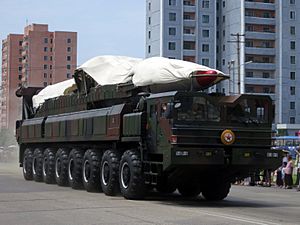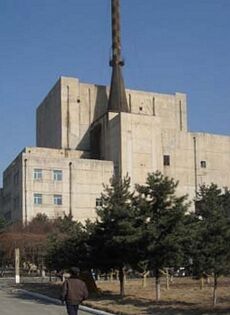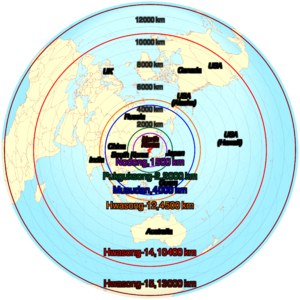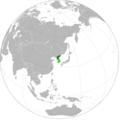North Korea and weapons of mass destruction facts for kids
Quick facts for kids Democratic People's Republic of Korea |
|
|---|---|
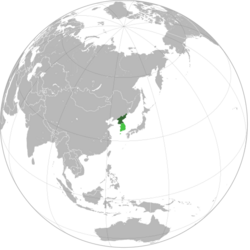 |
|
| First nuclear weapon test | October 9, 2006 |
| First thermonuclear weapon test | September 3, 2017 |
| Last nuclear test | September 3, 2017 |
| Largest yield test |
|
| Total tests | 6 |
| Current strategic arsenal | 50 weapons (2024 estimate) |
| Maximum missile range | 15,000 km (9,300 mi) Hwasong-17 |
| NPT party | Not a member (withdrew in 2003) |
North Korea has a military program to develop nuclear weapons. As of 2024, it is thought to have about 50 nuclear weapons. It also produces enough special material (called fissile material) for six to seven new nuclear weapons each year. North Korea also has many chemical and biological weapons. In 2003, North Korea left the Treaty on the Non-Proliferation of Nuclear Weapons (NPT), which is an agreement to stop the spread of nuclear weapons. Since 2006, the country has done six nuclear tests, which has led to other countries putting sanctions (penalties) on North Korea.
Contents
- How North Korea's Nuclear Program Started
- Agreements and Tests
- North Korea's Nuclear Weapons
- Nuclear Tests and Developments
- Making Fissile Material
- Nuclear Weapon Stockpile Estimates
- Chemical and Biological Weapons
- Delivery Systems (Missiles)
- Exports of Missile Technology
- International Responses
- International Inspections
- Images for kids
- See also
How North Korea's Nuclear Program Started
North Korea became interested in nuclear weapons in the 1950s. Their nuclear program really began around 1962. At that time, North Korea decided to become very militarized, meaning its military became a huge part of the country.
In 1963, North Korea asked the Soviet Union for help with nuclear weapons, but the Soviets said no. However, the Soviet Union did agree to help North Korea with peaceful nuclear energy and to train its scientists. Later, China also refused to help North Korea build nuclear weapons.
Soviet engineers helped build the Yongbyon Nuclear Scientific Research Center. A research reactor there started working in 1965. In 1979, North Korea began building a second reactor and plants to make fuel rods.
North Korea's nuclear weapons program grew in the 1980s. They focused on using nuclear energy for practical things and on making a full nuclear weapon system. They started working with uranium and did tests with high-explosives.
In 1985, North Korea joined the NPT. But it did not let the IAEA (an international nuclear watchdog) inspect its sites until 1992. In 1993, the IAEA found that North Korea's report on its nuclear materials was not complete. When North Korea refused more inspections, the IAEA told the UN Security Council. North Korea then said it would leave the NPT but changed its mind before it became final.
Agreements and Tests
In 1994, the U.S. and North Korea made a deal called the Agreed Framework. The U.S. agreed to help North Korea get two safer nuclear reactors if North Korea stopped its nuclear weapons program. These reactors were thought to be "more resistant" to making weapons material. However, the agreement faced problems and fell apart by 2002. Both sides blamed each other.
By 2002, Pakistan admitted that North Korea had gotten some of Pakistan's nuclear technology in the late 1990s. The U.S. then accused North Korea of not following the agreement and stopped oil shipments. North Korea said the U.S. misunderstood them. By the end of 2002, the Agreed Framework was officially over.
In 2003, North Korea again announced it was leaving the Nuclear Non-Proliferation Treaty. In 2005, it said it had nuclear weapons but promised to close its nuclear program.
First Nuclear Test in 2006
On October 9, 2006, North Korea announced it had successfully done its first nuclear test. An underground nuclear explosion was detected. It was a small blast, less than one kiloton (a kiloton is equal to 1,000 tons of TNT). Some radioactive material was found. On January 6, 2007, North Korea confirmed it had nuclear weapons.
In March 2007, North Korea said it would shut down its main nuclear facility. This was part of a deal from six-party talks (involving North Korea, South Korea, China, Russia, Japan, and the U.S.). North Korea was supposed to list its nuclear programs and disable its facility in exchange for fuel aid. This agreement broke down in 2009 after North Korea launched a satellite.
Second Nuclear Test in 2009
In April 2009, experts said North Korea had become a "fully fledged nuclear power." On May 25, 2009, North Korea did a second nuclear test. The explosion was estimated to be between 2 and 7 kilotons. This test, like the first, happened at Mantapsan. An earthquake was detected at the test site.
Nuclear Program in the 2010s
In February 2012, North Korea said it would stop making enriched uranium and would not do more nuclear tests if talks with the U.S. continued. They also agreed to stop long-range missile tests and let IAEA inspectors watch their Yongbyon facility. The U.S. agreed to send food aid. However, after North Korea launched a long-range missile in April 2012, the U.S. stopped the food aid.
On February 11, 2013, a seismic event (like an earthquake) was detected. North Korea said it was a third underground nuclear test with a smaller, more powerful warhead. South Korea estimated the blast at 6–9 kilotons.
On January 6, 2016, a similar seismic event happened. North Korea claimed this was a fourth underground nuclear test involving a hydrogen bomb. A hydrogen bomb is much more powerful than a regular atomic bomb. Experts doubted this claim because the explosion was too small (6–9 kilotons) for a true hydrogen bomb. They thought it might have been a "boosted fission device," which uses a small amount of hydrogen to make an atomic bomb more efficient.
On February 7, 2016, North Korea said it put a satellite into orbit. Many countries, including Japan and the U.S., criticized this, saying it was actually a test for an ICBM (a very long-range missile) disguised as a satellite launch.
A fifth nuclear test happened on September 9, 2016. This was the strongest test so far. South Korea estimated it at about 10 kilotons, while other sources suggested 20 to 30 kilotons.
In 2017, North Korea test-launched two ICBMs. The second one could reach the continental United States. In September 2017, North Korea announced another "perfect" hydrogen bomb test. This blast was much stronger, around 250 kilotons.
Recent Nuclear Policy Changes
Until 2022, North Korea said it would not use nuclear weapons first unless attacked. However, in 2022, a new law was passed. This law states that if North Korea's top leaders or nuclear control system are attacked, nuclear strikes would be launched automatically. It also says that if Kim Jong Un were killed, a senior official could authorize nuclear strikes.
North Korea's Nuclear Weapons
North Korea says it needed nuclear weapons because the U.S. has threatened it. North Korea has been thought to have a secret nuclear weapons program since the early 1980s. This is when it built a reactor at Yongbyon that could produce plutonium (a material used in nuclear bombs). Many countries have tried to get North Korea to use nuclear energy only for peaceful purposes.
In 1992, the International Atomic Energy Agency (IAEA) found problems during its first inspection in North Korea. They thought North Korea had processed more plutonium than it said. North Korea refused more access and said it would leave the NPT in 1993.
In 1994, North Korea promised to stop its plutonium programs under the Agreed Framework with the U.S. In return, it would get diplomatic relations and energy help.
By 2002, the U.S. believed North Korea was trying to get both enriched uranium and plutonium. North Korea reportedly told U.S. diplomats it had nuclear weapons, blaming the U.S. for not keeping its part of the Agreed Framework. North Korea later said it didn't have weapons yet but had "a right" to them. In late 2002 and early 2003, North Korea removed IAEA inspectors and started using spent fuel rods to make plutonium for weapons. North Korea left the Nuclear Non-Proliferation Treaty in 2003.
Nuclear Tests and Developments
2006 Nuclear Test
On October 9, 2006, North Korea did its first underground nuclear test. It used a plutonium-based device with a small yield of 0.2–1 kilotons. The test happened at Punggye-ri Nuclear Test Site. U.S. officials later confirmed the blast by finding radioactive material in air samples. The UN Security Council criticized the test and put sanctions on North Korea.
After 2006 Test
On January 6, 2007, North Korea confirmed it had nuclear weapons. In February 2007, North Korea agreed to shut down its main nuclear reactor. But in October 2008, IAEA inspectors were not allowed to inspect the site anymore.
2009 Nuclear Test
On April 25, 2009, North Korea said its nuclear facilities were working again. On May 25, 2009, North Korea did its second underground nuclear test. This test was stronger, estimated at 2 to 7 kilotons. A short-range missile test also happened that day.
2010 Nuclear Claims
In May 2010, North Korea claimed to have done nuclear fusion. This claim was mostly dismissed at the time.
2013 Nuclear Test
On February 12, 2013, monitors detected unusual seismic activity. North Korea said it had detonated a smaller nuclear device with "greater explosive force" underground. South Korean sources estimated the yield at 7.7–7.8 kilotons.
2015 Hydrogen Bomb Claim
In December 2015, Kim Jong Un said North Korea could launch a hydrogen bomb. This type of bomb is much more powerful than regular atomic bombs. The White House and South Korean officials were doubtful.
2016 Nuclear Tests
First Claimed Hydrogen Bomb Test
On January 7, 2016, after a magnitude 5.1 earthquake, North Korea said it had successfully tested a hydrogen bomb. Experts were doubtful because the explosion was relatively small. One expert said it might have been an atomic bomb or that the hydrogen part of the test did not work well.
Aftermath of Claimed Hydrogen Bomb Test

On March 9, 2016, North Korea showed a video of Kim Jong Un visiting a missile factory with a silver sphere, claiming it was a miniaturized nuclear bomb. Experts were skeptical, saying a hydrogen bomb would look different and have two parts. Many countries and the UN criticized these tests as dangerous.
First Nuclear Warhead Test Explosion
On September 9, 2016, a 5.3 seismic tremor was detected. North Korea confirmed another nuclear test. They said this test confirmed their warhead could be put on a missile and verified its power.
2017 Nuclear and Missile Tests
In February 2017, China stopped importing coal from North Korea to follow UN sanctions. On March 6, 2017, North Korea launched four ballistic missiles. This led to increased international tension.
On April 15, 2017, North Korea held a large military parade. They showed new intercontinental ballistic missile-sized containers and submarine-launched missiles. Hours later, North Korea tried to launch a ballistic missile, but it exploded shortly after takeoff.
On July 4, 2017, North Korea launched a Hwasong-14 missile. It flew very high and far, showing it could reach all of Alaska. On July 28, a second, more advanced ICBM was launched, capable of reaching the continental United States. However, the missile's re-entry vehicle broke up, meaning it wasn't ready for combat.
On August 8, 2017, The Washington Post reported that U.S. intelligence believed North Korea had made a nuclear warhead small enough to fit on its long-range missiles. On September 3, 2017, North Korea claimed to have successfully tested a thermonuclear bomb (hydrogen bomb). The seismic activity was very strong, suggesting a blast around 250 kilotons.
On November 20, 2017, the U.S. called North Korea a "state sponsor of terrorism" again. On November 28, 2017, North Korea fired an ICBM. Kim Jong Un said they had "finally realized the great historic cause of completing the state nuclear force."
2019 Developments
In August 2019, Japan said North Korea seemed to have made its warheads smaller. Japan's defense report called North Korea's nuclear and missile programs a "serious and imminent threat."
2020 Developments
In June 2020, one expert estimated North Korea had built "eight or more additional nuclear weapons" since 2018. On October 10, 2020, North Korea showed a huge ICBM at a military parade. Experts believe it is one of the world's largest road-mobile ballistic missiles.
2022 Developments
In the first four weeks of 2022, North Korea did seven missile tests. On September 9, 2022, North Korea passed a law declaring itself a nuclear weapons state and said it would never give up its nuclear weapons.
2023 Developments
On March 24, 2023, North Korea showed the Hwasan-31 tactical nuclear bomb. It had at least 10 warheads. In December 2023, North Korea launched an ICBM that South Korea and Japan said could hit any target in the USA.
2024 Developments
In April 2024, North Korea claimed to have tested a new system for controlling nuclear attacks in a simulated counterattack.
Making Fissile Material
Plutonium Facilities
North Korea's plutonium-based nuclear reactors are at the Yongbyon Nuclear Scientific Research Center, about 90 km north of Pyongyang.
- One Soviet-supplied IRT-2000 research reactor, finished in 1967. This reactor was used for North Korea's first plutonium separation tests.
- A newer nuclear reactor with a capacity of 5 MWe. This is North Korea's main reactor for producing plutonium. It can make about 6 kg of plutonium per year.
- Two Magnox reactors (50 MWe and 200 MWe) were being built but stopped in 1994. If finished, they could produce much more plutonium.
- A fuel reprocessing facility that gets uranium and plutonium from spent fuel. Its work was stopped in 1994 but restarted in 2009.
In 1993, North Korea said it would leave the Nuclear Non-Proliferation Treaty (NPT) and refused IAEA inspectors. By 1994, the U.S. thought North Korea had enough plutonium for about 10 bombs. North Korea agreed to stop its plutonium program as part of the Agreed Framework. In return, South Korea and the U.S. would give North Korea light water reactors and fuel oil. These reactors would make it harder to hide nuclear material. However, the Agreed Framework had many problems and the reactors were never finished. In late 2002, North Korea went back to using its old reactors.
In 2006, eight sites were identified as possible test explosion sites for military purposes:
- Hamgyong Bukdo (North Hamgyong) Province – two sites: Chungjinsi and Kiljugun (site of 2009 test), and Phunggyere (site of 2006 test).
- Chagangdo Province – one site: Kanggyesi.
- Pyongan Bukdo (North Pyongan) Province – four sites: Yongbyonsi (two sites), Kusungsi, and Taechongun.
- Pyongan Namdo (South Pyongan) Province – one site: Pyongsungsi.
Highly Enriched Uranium Program
North Korea has uranium mines with about 4 million tons of high-quality uranium ore.
Pakistan's top scientist, Abdul Qadeer Khan, reportedly gave North Korea information on uranium enrichment in the 1990s. This was possibly in exchange for missile technology. In 2005, Pakistan admitted Khan had given centrifuges and their designs to North Korea.
The program for Highly enriched uranium (HEU) became public in October 2002. North Korea had agreed not to have enrichment facilities under the Agreed Framework. The U.S. said North Korea broke this promise.
In December 2002, the U.S. stopped fuel oil shipments, ending the Agreed Framework. North Korea then announced it would restart its nuclear fuel processing program. It also expelled UN inspectors and said it was leaving the Non-Proliferation Treaty.
In 2007, a U.S. official believed North Korea had materials for a large-scale uranium program. Construction of a uranium enrichment facility likely started in 2002 at a site called Kangson.
In September 2021, CNN reported that North Korea was expanding its uranium enrichment facility at Yongbyon. This expansion could increase its output of highly enriched uranium by up to 25% yearly.
Nuclear Weapon Stockpile Estimates
Experts have different ideas about how many nuclear weapons North Korea has:
- RECNA (June 2020): Up to 35 nuclear weapons.
- Bulletin of the Atomic Scientists (January 2018): Enough material for 30 to 60 nuclear weapons, and possibly 10 to 20 assembled weapons.
- Defense Intelligence Agency (August 2017): North Korea had made a miniaturized nuclear warhead for missiles and could have up to 60 warheads. By 2019, they estimated North Korea had enough material for 65 weapons and was making up to 12 new ones each year.
- Siegfried S. Hecker (August 2017): Enough material for 20 to 25 nuclear weapons. He thought they needed more tests for ICBM warheads. In February 2019, he estimated enough material for 35 to 37 nuclear weapons.
- Institute for Science and International Security (2017): Estimated 13 to 30 nuclear weapon equivalents, increasing to as many as 60 later that year. In 2023, they estimated 35 to 65 nuclear warheads.
- FAS (2012): Fewer than 10 plutonium warheads. In January 2018, they estimated enough material for 30 to 60 weapons, with 10 to 20 assembled.
- SIPRI (January 2013): 6 to 8 warheads. In June 2020, they said North Korea added 10 nuclear weapons to its stockpile, making it 20 to 30.
- Korea Institute for Defense Analyses (2023): Between 80 and 90 nuclear warheads, possibly up to 166 by 2030.
Chemical and Biological Weapons
North Korea started developing its chemical weapon (CW) program in 1954. By the late 1980s, its chemical weapons capabilities had grown. Experts believe North Korea has about 2,500 to 5,000 metric tons of chemical weapons. These include mustard gas (a blister agent) and nerve agents like sarin.
In 2014, South Korea estimated North Korea had 2,500 to 5,000 tons of chemical weapons. It also said North Korea could produce various biological weapons. The U.S. Department of Defense reported in 2015 that North Korea likely has chemical weapons and can use them with missiles. They also said North Korea is developing biological weapons like anthrax.
North Korea has signed the Geneva Protocol, which bans the use of chemical weapons in war. It has also signed the Biological Weapons Convention (BWC). However, North Korea is not part of the Chemical Weapons Convention (CWC), which bans chemical weapons.
North Korea has not admitted to having chemical weapons, despite UN requests. After an attack in 2010, South Korea gave out gas masks and renovated shelters.
In 2015, an expert analyzed a photo of Kim Jong Un visiting a factory. The expert believed the factory, supposedly for pesticides, actually produced weaponized anthrax. North Korea denied this and invited the U.S. Congress to inspect the factory.
North Korea has different types of chemical weapons, including nerve, blister, blood, and vomiting agents. It also has biological weapons like anthrax, smallpox, and cholera. In 2017, Kim Jong-nam, Kim Jong Un's half-brother, was killed with VX nerve agent in Malaysia. North Korea is thought to be one of the world's largest holders of chemical weapons.
Delivery Systems (Missiles)
North Korea's ability to deliver weapons of mass destruction depends on its missile technology. In 2005, its Nodong missiles could reach 900 km. This is enough to reach South Korea and parts of Japan, Russia, and China. The Hwasong-10 missile can reach up to 2,490 km and could carry a nuclear warhead.
In 2016, an Israeli expert said North Korea's missile program had made "remarkable achievements." In January 2020, a U.S. official said North Korea was building new missiles "as fast as anybody on the planet."
Experts estimate that short-range ballistic missiles like KN-23 and KN-24 are very accurate. The Congressional Research Service reported that North Korea has made nuclear warheads small enough for short-range and intercontinental ballistic missiles.
Operational Missile Systems
North Korea seems to have made nuclear warheads small enough for ballistic missiles. Japan and South Korea believe North Korea can miniaturize nuclear weapons. It is not known if North Korea has the technology to protect its missiles when they re-enter the atmosphere.
North Korea has about 300 Rodong missiles, which can reach 1,300 km. In August 2016, a Rodong missile test landed near Japan, causing Japan to criticize the "unforgivable act of violence."
North Korea appeared to launch a missile from a submarine in April 2016. While it only flew 30 km, one U.S. analyst said North Korea's submarine launch ability had become "very serious." However, progress on submarine-launched ballistic missiles (SLBM) seems slow as of 2023.
The U.S. is putting sanctions on people and groups in China for helping North Korea's weapons programs.
Missiles Tested or Operational
- Hwasong-5: A road-mobile, liquid-fueled missile with a range of about 330 km. North Korea has about 150–200 of these.
- Hwasong-6: An improved Hwasong-5 with a range of 550–700 km. This is North Korea's most common missile, with at least 400 in use.
- Hwasong-7: A larger, more advanced missile with a range of 1,300 to 1,600 km. Later versions use GPS for better accuracy.
- Hwasong-9: Also called Scud-ER, it can reach 1,000+ km and hit Japan.
- Hwasong-10: Also known as Musudan, it has a predicted range of 2,500–4,000 km.
- Hwasong-11: A short-range, solid-fueled, accurate mobile missile.
- Pukguksong-1: A long-range, solid-fueled missile launched from submarines (SLBM).
- Pukguksong-2: A land-based version of the Pukguksong-1.
- Hwasong-12: A medium-range, liquid-fueled, mobile missile. Tested in May 2017, with an estimated range of 5,000 to 6,000 km.
- Hwasong-14: A long-range ICBM, tested in July 2017. Estimated range is 6,700–10,000 km.
- Hwasong-15: Has a 13,000 km range, successfully tested in November 2017.
- KN-23: A short-range missile with a 700 km range, tested in May 2019. It can reach 800 km.
- Hwasong-17: A very long-range ICBM, potentially over 15,000 km. It was likely successfully tested in November 2022. Its accuracy and ability to survive re-entry are still unknown.
Untested Missiles
- KN-08: A road-mobile ICBM with a maximum range over 5,500 km. Its development was stopped due to engine problems.
Exports of Missile Technology
In April 2009, the UN named the Korea Mining and Development Trading Corporation (KOMID) as North Korea's main arms dealer. KOMID sells equipment related to ballistic missiles and weapons worldwide.
KOMID has sold missile technology to Iran and has dealt with Taiwan. It has also sold missile technologies, gunboats, and rocket artillery worth over $100 million to countries in Africa, South America, and the Middle East.
North Korea's military also used a company called Hap Heng to sell weapons. Hap Heng, based in Macau in the 1990s, handled sales of weapons and missile/nuclear technology to Pakistan and Iran. Pakistan's Ghauri missile is thought to be a copy of North Korea's Rodong 1.
A UN report said North Korea runs a smuggling network for nuclear and missile technology, including to Myanmar, Syria, and Iran. North Korea gets missile parts from Western countries by avoiding international sanctions.
Countries Buying North Korean Missiles
Several countries have bought North Korean ballistic missiles or received help to make their own:
 Egypt: Received technology for Hwasong-5 and Hwasong-6 missiles.
Egypt: Received technology for Hwasong-5 and Hwasong-6 missiles. Iran: Bought North Korean missiles early on. Iran makes local versions of Hwasong-5 (Shahab-1), Hwasong-6 (Shahab-2), and Rodong-1 (Shahab-3). Iran also has BM25 Musudan missiles.
Iran: Bought North Korean missiles early on. Iran makes local versions of Hwasong-5 (Shahab-1), Hwasong-6 (Shahab-2), and Rodong-1 (Shahab-3). Iran also has BM25 Musudan missiles. Pakistan: North Korea helped Pakistan's ballistic missile program in the late 1990s in exchange for nuclear weapons technology. Pakistan's Ghauri missile is based on North Korea's Nodong missile.
Pakistan: North Korea helped Pakistan's ballistic missile program in the late 1990s in exchange for nuclear weapons technology. Pakistan's Ghauri missile is based on North Korea's Nodong missile. Syria: Got Scud-B missiles from North Korea. North Korea may have helped Syria develop other Scud missiles. A 2018 UN report said North Korea sent technicians and materials to Syria for its chemical weapons program.
Syria: Got Scud-B missiles from North Korea. North Korea may have helped Syria develop other Scud missiles. A 2018 UN report said North Korea sent technicians and materials to Syria for its chemical weapons program. United Arab Emirates: Bought 25 Hwasong-5s in 1989, but were not happy with the quality.
United Arab Emirates: Bought 25 Hwasong-5s in 1989, but were not happy with the quality. Vietnam: Reportedly ordered Hwasong-5/6 missiles in 1998–99.
Vietnam: Reportedly ordered Hwasong-5/6 missiles in 1998–99. Yemen: Bought Scud missiles from North Korea in the 1990s.
Yemen: Bought Scud missiles from North Korea in the 1990s.
Former Export Partners
 Libya: Received technology, blueprints, and missile parts from North Korea under Muammar Gaddafi.
Libya: Received technology, blueprints, and missile parts from North Korea under Muammar Gaddafi.
Rejected by a Potential Partner
 Nigeria: In 2004, Nigeria agreed to buy missile technology from North Korea but later rejected the deal due to U.S. pressure.
Nigeria: In 2004, Nigeria agreed to buy missile technology from North Korea but later rejected the deal due to U.S. pressure.
International Responses

In the 1990s, the U.S. tried to stop North Korea's nuclear program through the Agreed Framework. This failed when North Korea's secret uranium enrichment program was found in 2002. After that, China organized the six-party talks to try to get North Korea to give up its nuclear weapons step-by-step. These talks stopped after North Korea did more nuclear and missile tests. This led to more international sanctions from the United Nations Security Council.
In 2018, Presidents Moon Jae-in of South Korea and Donald Trump of the United States met with Kim Jong Un. They made statements supporting the idea of getting rid of nuclear weapons on the Korean peninsula.
International Inspections
On October 31, 2018, a South Korean lawmaker said that South Korean intelligence officials had looked at several of North Korea's nuclear and missile test sites. These sites were ready for upcoming international inspections. The inactive Punggye-ri Nuclear Test Site and the Sohae Satellite launching ground were included. This visit was part of the September 2018 Pyongyang Agreement. In this agreement, Kim Jong Un agreed to close Sohae and let international experts watch the dismantling of the missile engine testing site and a launch pad. Experts will also be allowed to see other North Korean nuclear and missile test sites being taken apart. Yongbyon, North Korea's main nuclear facility, has also been inactive but is not completely closed yet.
Images for kids
See also
- Korean conflict
- Korean reunification
- 2017–18 North Korea crisis
- 2002 State of the Union Address
- Foreign relations of North Korea
- List of nuclear weapons tests of North Korea
- North Korea–Pakistan relations
- North Korea–United States relations
- Nuclear power in North Korea
- Sohae Satellite Launching Station
- North Korea nuclear disarmament
- South Korea and weapons of mass destruction



